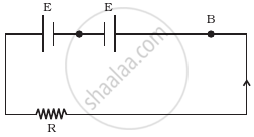Advertisements
Advertisements
प्रश्न
Will current flow more easily through a thick wire or a thin wire of the same material, when connected to the same source? Why?
Will current flow more easily through a thick wire or a thin wire of the same material when connected to the same source? Give reason for your answer.
उत्तर १
The current will flow more easily through thick wire. It is because the resistance of a
conductor is inversely proportional to its area of cross-section. If thicker the wire, less is resistance and hence more easily the current flows.
उत्तर २
Resistance (R) is inversely proportional to the area of the cross-section (A) of the
wire. So, thicker the wire, lower is the resistance of the wire and vice-versa.
Therefore, current can flow more easily through a thick wire than a thin wire.
`R = rho xx l/A`
`R ∝ 1/A`
उत्तर ३
The resistance of a conductor is inversely proportional to its area of cross-section, i.e. `R ∝ 1/A`. So as the conductor is a thick wire, its resistance decreases and current will flow easily through it, in comparison with a thin wire.
APPEARS IN
संबंधित प्रश्न
When a 12 V battery is connected across an unknown resistor, there is a current of 2.5 mA in the circuit. Find the value of the resistance of the resistor.
The graph between V and I for a conductor is a straight line passing through the origin.
Which law is illustrated by such a graph?
State Ohm’s law and draw a neat labelled circuit diagram containing a battery, a key, a voltmeter, an ammeter, a rheostat and an unknown resistance to verify it.
An electric bulb draws 1.2 A current at 6.0 V. Find the resistance of filament of bulb while glowing.
A car bulb connected to a 12 volt battery draws 2 A current when glowing. What is the resistance of the filament of the bulb? Will the resistance be more same or less when the bulb is not glowing?
Calculate the current flowing through a wire of resistance 5 Ω connected to a battery of potential difference 3 V.
How would you connect two resistors in series? Draw a diagram. Calculate the total equivalent resistance.
Define the following:
(i) Coulomb
(ii) Ohm
The filament of a bulb takes a current 100 mA when potential difference across it is 0.2 V. When the potential difference across it becomes 1.0 V, the current becomes 400 mA. Calculate the resistance of filament in each case and account for the difference.
State and define Ohm’s law.
SI unit of resistance is:
An electronics hobbyist is building a radio which requires 150 Ω in her circuit, but she has only 220 Ω, 79 Ω, and 92 Ω resistors available. How can she connect the available resistors to get the desired value of resistance?
Which of the following is correct for V-I graph of a good conductor?

Calculate the total resistance of the circuit and find the total current in the circuit.
Consider a current carrying wire (current I) in the shape of a circle. Note that as the current progresses along the wire, the direction of j (current density) changes in an exact manner, while the current I remain unaffected. The agent that is essentially responsible for is ______.
Two cells of same emf E but internal resistance r1 and r2 are connected in series to an external resistor R (Figure). What should be the value of R so that the potential difference across the terminals of the first cell becomes zero.
What is meant by resistance of a conductor ? Define its SI unit.
